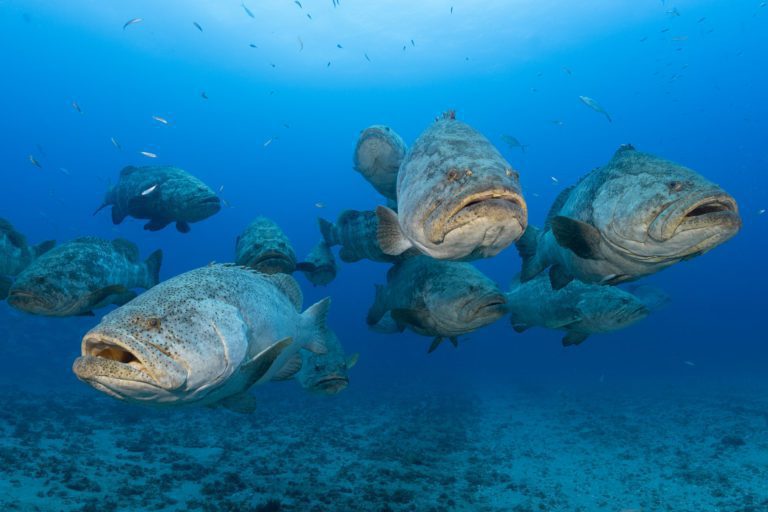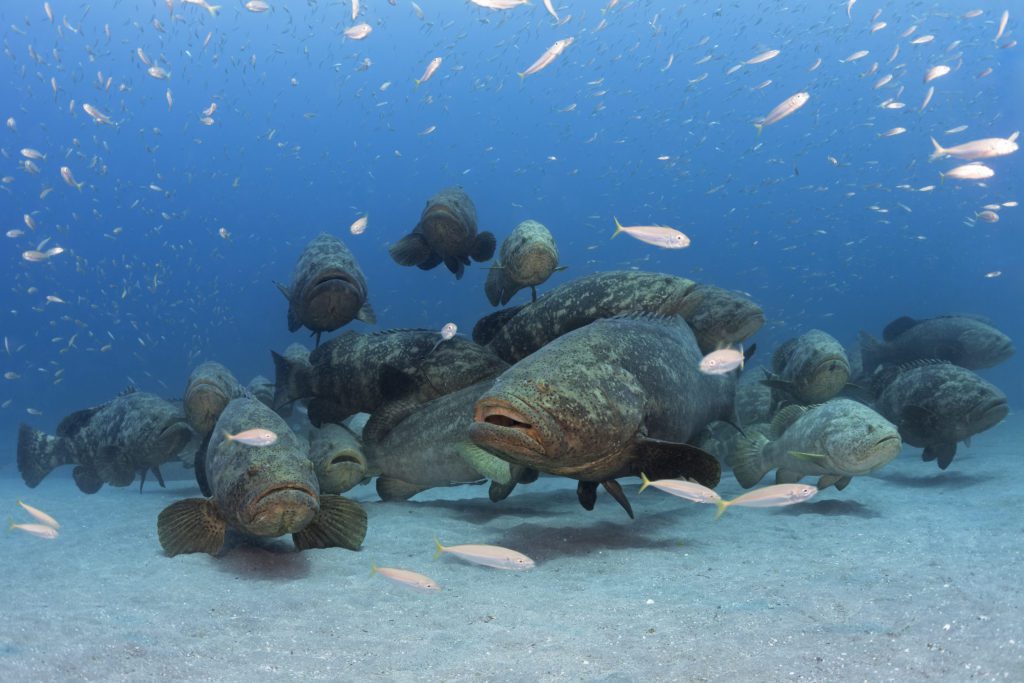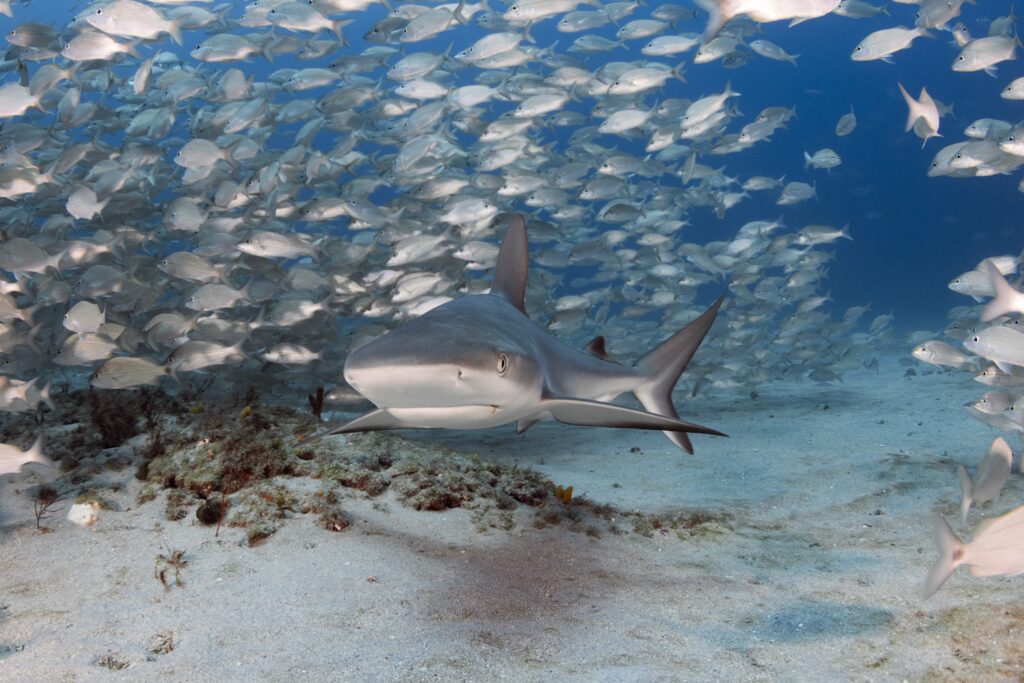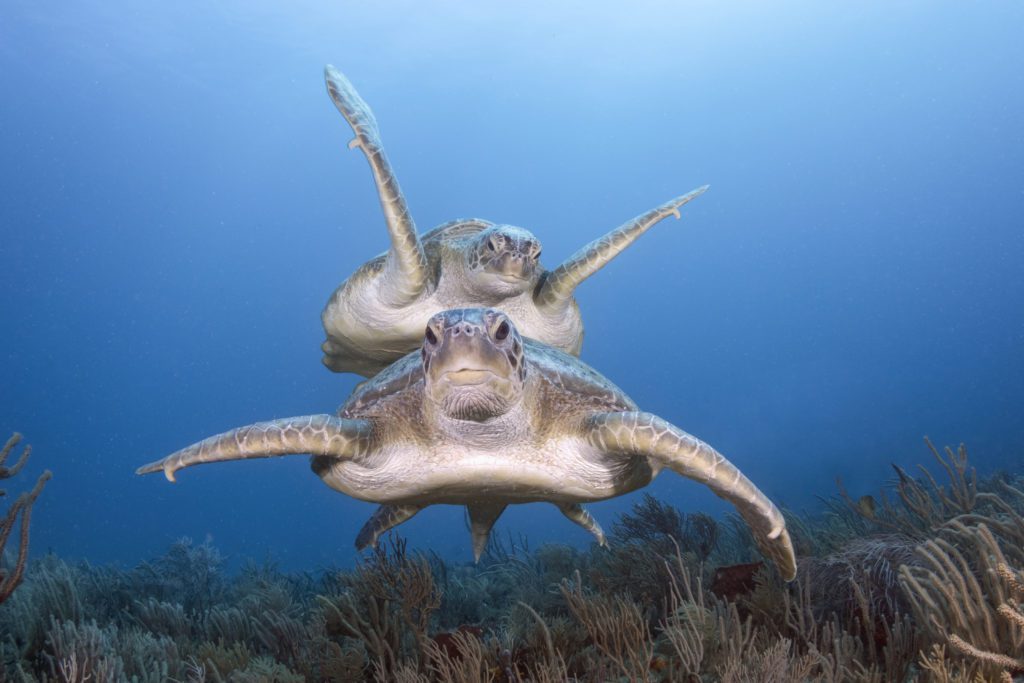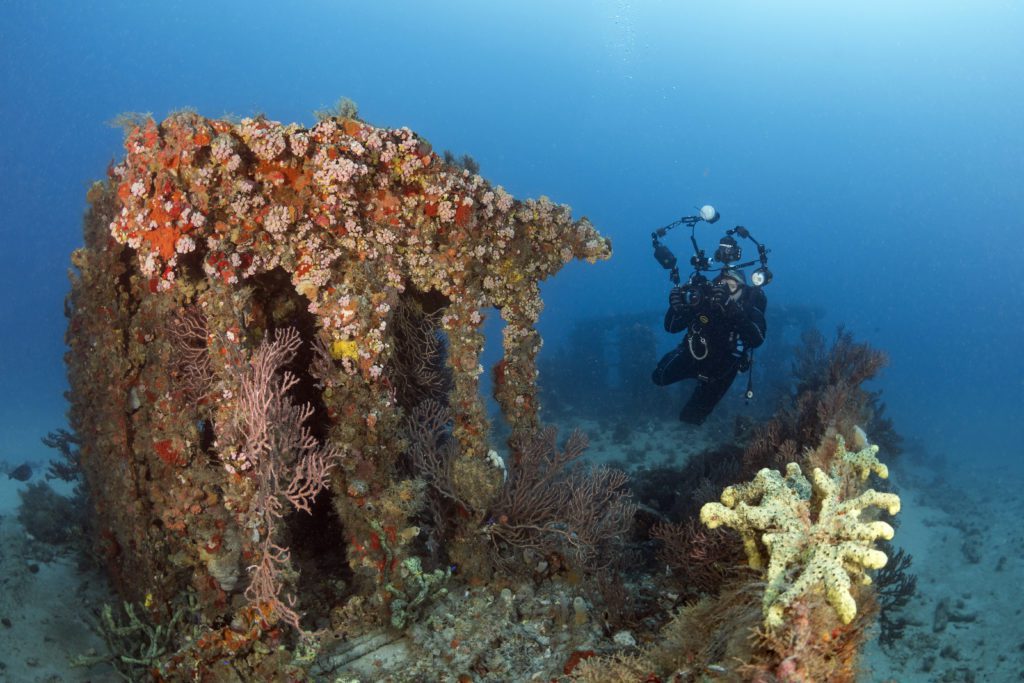They’re among the most awe-inspiring mega-fish likely to be encountered on a dive, especially when massive aggregations form, and Florida is the place to go if you want to meet them. WALT STEARNS explains
Goliath grouper (Epinephelus itajara) are the largest predatory, reef-dwelling bony fish found in the tropical Atlantic and Caribbean. To lay eyes on one can turn a dive into a series of wow moments, because these grouper can be as big around as a barrel, weighing in at as much as 230kg. Size one up next to your dive-buddy and try to decide – which of them is bigger?
Sadly, your odds of seeing one on your Caribbean travels now range from exceedingly rare to non-existent, the result of overfishing. Most destinations have eradicated the fish from their waters, sadly consigning them to a bygone era.
But off the coast of south Florida it’s a different story, because for now these mammoth grouper are a protected species, making the likelihood of meeting one face to face just about a guarantee – if you know where to go. And for me, the Palm Beach County coast is “the place”.
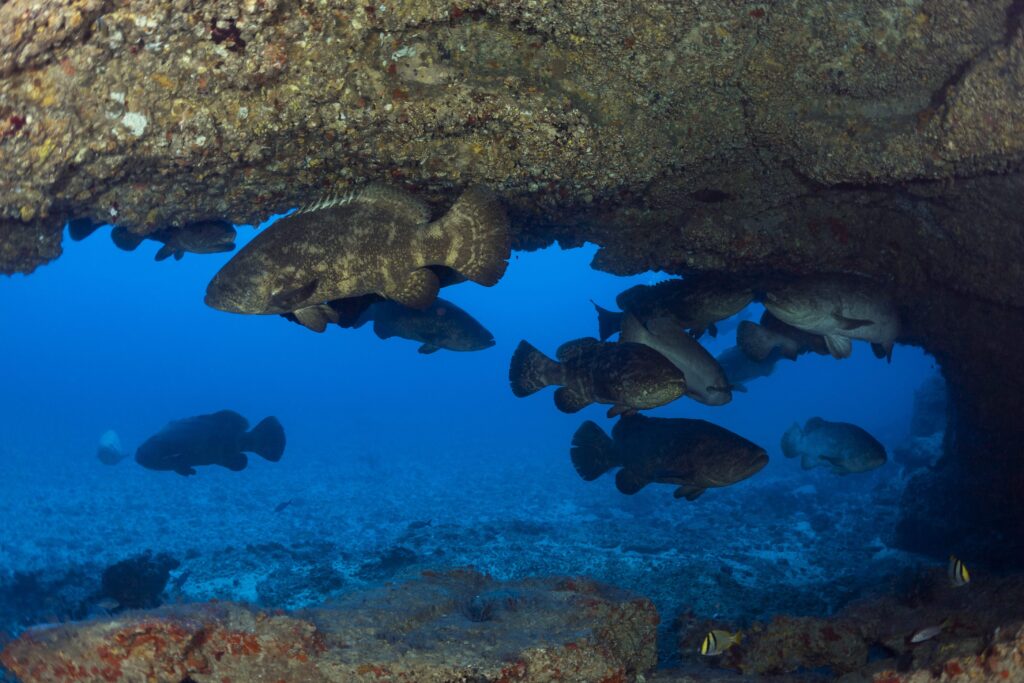
Drop in on a wreck or reef formation with a deep undercut and you’re likely to encounter a Goliath grouper. They are such a regular attraction that many dive-charter operations have named several individuals, such as Shadow, Braveheart and Wilbur.
Seeing one, two or even three of these enormous grouper together makes for a moment few will forget. And come the end of summer, a very special event occurs that divers will find nowhere else on the planet – Goliath grouper spawning aggregations, with from 40 to as many as 90-plus fish in attendance.
Spawning season
The months of August and September are Goliath spawning season, and the annual event takes place at a handful of key sites spread between Palm Beach County’s eastern shoreline and the southern Gulf of Mexico 40 miles off Florida’s west coast.
Between these two regions, the Palm Beach coast is the most accessible, because the aggregation sites for the state’s east coast population is a mere 3-5 miles offshore, with water depths averaging 20-30m.

Compared to most grouper species, the Goliath’s path to romance is more marathon than sprint. It starts with resident fish assembling around the end of July at specific sites such as the MG-111 river barge and the Zion Train / Bonaire wrecks in Jupiter, the Ana Cecilia / Mizpah wrecks in West Palm Beach and down to the Castor wreck off Boynton Beach.
By mid-August, resident fish are joined by their northern neighbours, some having travelled as much as 350 miles up the coast, swelling the ranks of any given site to 50 or more.
Despite their formidable size and somewhat dense demeanour, Goliaths are not the ferocious brutes some spearfishers would have us believe.
For the most part, they can be big babies. When threatened, they sound off with a short series of loud booms, sometimes accompanied by a brief succession of head and body shakes that make the fish look as if it’s having a mild seizure.
This is generally all posturing, with a few barks but no bite, typically ending with the fish retreating to a safer distance or disappearing into a deep hole in the reef or wreck the moment their bluff is called.

During spawning season, there is even less to be afraid of, because the fish are no more territorial than they are at any other time of the year. Even a large group of 20 or more grouper will not stand in your way should anyone advance into their space. If anything, they will often break to one side or the other, like a group of park pigeons.
Overall, these fish’s behaviour around scuba divers falls into three categories: reclusive, as in “keep your distance, I don’t trust you”; total indifference as in “oh, you’re here again, what else is new?”; or, occasionally, you might run into a fish or two that not only doesn’t move away, but makes a point of coming up to say hello.
Don’t be surprised if she decides to saddle up next to you or your buddy. When a Goliath is this compliant, you could theoretically do almost anything short of giving it a bear-hug.

Supermodels: Rules to follow
Some of the local underwater photographers refer to these fish as “supermodels” because they will hold position, allowing the diver to fire shot after shot! If you happen to meet one of these fish, there are a few simple rules to follow:
1. Don’t put your hands in front of the fish’s face, because this could result in it biting you.
2. Keep your movements slow and deliberate – like anyone else, these fish don’t enjoy being surprised.
3. Don’t chase the fish. Your best results will come by following rule 2.
As a longtime resident of Palm Beach I feel highly privileged to have been able to spend many years diving with these charismatic, slightly goofy-looking megafauna. My list of memorable seasonal gatherings goes back to 2001, when the first spawning aggregation returned to a site called the Hole-in-the-Wall – following a three-decade absence.
Back then, there were only 27 fish, but it was really cool to witness. On a dive in 2012 on the Zion Train / Bonaire wreck-site, which sits in 27m of water, I was able to count 90-plus individuals. Among my collection of images that season is a shot with 67 fish in one frame.
In terms of sheer numbers of fish gathered in one setting, near the close of the season in late September, the Boynton Beach area’s Castor wreck – which sits in 33m, with an 18m profile – once took on an unprecedented number of fish that surpassed 130, although only days before the number of fish present had been below half that figure.
This unusual influx was most likely the result of a string of coldwater upwellings that plagued the spawning sites in the Jupiter and West Palm area, causing the fish to go south to avoid it. Goliaths are no fans of cold water.
I’m in a high state of anticipation as to what I might see next time I drop in on that special wreck. I hope to be greeted once again by 40 to 50 of these mammoth grouper. Wanna join me?
Will I see them spawn?
What divers typically see during daylight hours on any given spawning aggregation site are a collection of colossal Goliaths either formed into a single group, or in a collection of subgroups hanging close to one another. Typically, the fish will mill about idly as if saying: “OK, we’re all here, now what?”
A feature that has frustrated fishery biologists and underwater photographers alike is that Goliath grouper don’t follow the same spawning ritual as their closer kin, the Nassau grouper (Epinephelus striatus).
Nassaus generally spawn in a mass under a full moon in winter, whereas Goliaths will spawn under cover of darkness over a 6-7-night period during the new moon of August and September. This behaviour has made it impossible – so far – for anyone to document the act of spawning.
Goliaths don’t have it easy
Something else to consider when witnessing these encounters is that the spawning was once quite common, and now has become vanishingly rare. The historical range for Goliath grouper once spanned the entire breadth of the tropical Atlantic, from the south-eastern USA down through the Caribbean and the Central American coast to Brazil, as well as the West African coast in the Gulf of Guinea.
Because of relentless fishing pressure throughout its range, the Goliath species sits on the edge of being wiped out, which is why the IUCN has it Red-listed as a Critically Endangered species. Currently Florida is the only region in which stocks have returned from a state of collapse. This makes Florida’s spawning critically important to the survival of the species.
That’s just the start…
Palm Beach County’s coast offers far more than Goliath grouper. This 45-mile stretch along Florida’s south-east coast is often called the Florida Gold Coast, a title that originated from the treasure lost by Spanish galleons that sank offshore and found in the region.
That region is steeped in incredibly diverse marine life. On any given dive, in addition to Goliath grouper divers can be treated to encounters with sea turtles (all five of the Atlantic species come here), sharks (lemon, bull and reef are the trademark species) and, of course, loads of fish life.
The primary influencer is the Gulf Stream, the second largest oceanic current on the planet, flowing north from the western Caribbean past the Florida coast and on into the north Atlantic all the way to the British Isles.
This mighty “river within the sea” not only provides divers with clearer water than anywhere else along Florida’s east coast, but its constant flow enlivens the area’s reefs and wrecks, bringing the nutrition needed for corals, sponges and fish to thrive.
It’s fairly well-known that most diving destinations provide access to more than just one wreck, but few have these sunken vessels concentrated in such a way that a diver can explore two to four on a single submersion. Thy can in Palm Beach County. For example, the site local operators call the Corridor comprises six wrecks, resting on the bottom in a line.
This is so that divers working with the Gulf Stream’s northerly flow can bounce from wreck to wreck. First in line here is the Ana Cecilia, a 52m cargo ship sitting upright on the bottom in 26m of water, followed by the remains of the Mizpah and PC-1174, which are then followed by the Amaryllis.
The story on the latter is that all the decks and superstructure on the 137m ship were removed when she was salvaged after washing ashore during a hurricane. Today, locals refer to the Amaryllis as “the 450-foot canoe”. After that experience you can hit the China Barge, an upside-down 24m barge, and the “Brazilian Docks”, piles of concrete dock rubble and culverts.
The Corridor is by no means Palm Beach County’s only signature wreck combination. A short boat-ride from the Lake Worth Inlet is Governor’s Riverwalk, which comprises four large coastal freighters that were placed 27m deep in February 2002 as part of the county’s artificial-reef programme.
The first three in the collection went down in length order, starting with the Shasha Boekanier (56m) followed by the St Jacques (55m) and the Gilbert Sea (52m).
Nine months later a fourth vessel, the Thozina (53m) was added to the group, landing directly behind the Gilbert Sea and completing Governor’s as a spectacular artificial-reef system. All dives off the coast are conducted as drifts, and the entire group can be covered in one dive.
With Goliath grouper, turtles, sharks, loads of fish life, reefs, wrecks, shore-diving at the Blue Heron Bridge and of course, blackwater diving opportunities, what more do you need for a fantastic south Florida diving adventure?
Photographs by Walt Stearns
Also on Divernet: Jupiter – Out Of This World, Sponges: Glue Of The Reef, Early USA Coin Found On British Shipwreck, Coral Farmers Reshaping The Future
